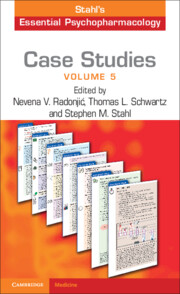4182 results
‘The boots will be on the coffin!’: multiple meanings of ageing for older people playing walking football
-
- Journal:
- Ageing & Society , First View
- Published online by Cambridge University Press:
- 24 April 2024, pp. 1-18
-
- Article
-
- You have access
- Open access
- HTML
- Export citation
Neonatal anthropometric indicators of infant growth and mortality in Burkina Faso
-
- Journal:
- Public Health Nutrition / Accepted manuscript
- Published online by Cambridge University Press:
- 19 April 2024, pp. 1-16
-
- Article
-
- You have access
- Open access
- Export citation
Contents
-
- Book:
- Case Studies: Stahl's Essential Psychopharmacology
- Published online:
- 03 April 2024
- Print publication:
- 18 April 2024, pp v-x
-
- Chapter
- Export citation
List of icons
-
- Book:
- Case Studies: Stahl's Essential Psychopharmacology
- Published online:
- 03 April 2024
- Print publication:
- 18 April 2024, pp xvii-xviii
-
- Chapter
- Export citation
Copyright page
-
- Book:
- Case Studies: Stahl's Essential Psychopharmacology
- Published online:
- 03 April 2024
- Print publication:
- 18 April 2024, pp iv-iv
-
- Chapter
- Export citation
Introduction
-
- Book:
- Case Studies: Stahl's Essential Psychopharmacology
- Published online:
- 03 April 2024
- Print publication:
- 18 April 2024, pp xi-xiv
-
- Chapter
- Export citation
Index of drug names
-
- Book:
- Case Studies: Stahl's Essential Psychopharmacology
- Published online:
- 03 April 2024
- Print publication:
- 18 April 2024, pp 481-484
-
- Chapter
- Export citation
Contributors
-
- Book:
- Case Studies: Stahl's Essential Psychopharmacology
- Published online:
- 03 April 2024
- Print publication:
- 18 April 2024, pp xv-xvi
-
- Chapter
- Export citation
Abbreviations
-
- Book:
- Case Studies: Stahl's Essential Psychopharmacology
- Published online:
- 03 April 2024
- Print publication:
- 18 April 2024, pp xix-xxiv
-
- Chapter
- Export citation
Index of case studies
-
- Book:
- Case Studies: Stahl's Essential Psychopharmacology
- Published online:
- 03 April 2024
- Print publication:
- 18 April 2024, pp 485-492
-
- Chapter
- Export citation
Keratin-based topical cream for radiation dermatitis during head and neck radiotherapy: a randomised, open-label pilot study
-
- Journal:
- Journal of Radiotherapy in Practice / Volume 23 / 2024
- Published online by Cambridge University Press:
- 15 April 2024, e11
-
- Article
-
- You have access
- Open access
- HTML
- Export citation
VaTEST III: Validation of 8 Potential Super-Earths from TESS Data
-
- Journal:
- Publications of the Astronomical Society of Australia / Accepted manuscript
- Published online by Cambridge University Press:
- 11 April 2024, pp. 1-22
-
- Article
- Export citation
259 Eighty-six-fold increase in HIV diagnosis with “Opt-out” Screening: Frontlines of Communities in the U.S. (FOCUS) Program in the UHealth Tower (UHT) Emergency Department (ED) - path to eliminate HIV transmission in the U.S.
- Part of
-
- Journal:
- Journal of Clinical and Translational Science / Volume 8 / Issue s1 / April 2024
- Published online by Cambridge University Press:
- 03 April 2024, pp. 78-79
-
- Article
-
- You have access
- Open access
- Export citation
546 Using Contingency Management to Understand the Cardiovascular, Immune and Psychosocial Benefits of Reduced Cocaine Use: A Protocol for a Randomized Controlled Trial
- Part of
-
- Journal:
- Journal of Clinical and Translational Science / Volume 8 / Issue s1 / April 2024
- Published online by Cambridge University Press:
- 03 April 2024, p. 163
-
- Article
-
- You have access
- Open access
- Export citation
99 Using LGBTQ+ Community Expertise to Co-Develop Inclusive Sexual Orientation and Gender Identity (SOGI) Screening for Research Studies
- Part of
-
- Journal:
- Journal of Clinical and Translational Science / Volume 8 / Issue s1 / April 2024
- Published online by Cambridge University Press:
- 03 April 2024, pp. 27-28
-
- Article
-
- You have access
- Open access
- Export citation
353 Eph/Ephrin Signaling Influences Innervation of Outer Hair Cells in Cochlea
- Part of
-
- Journal:
- Journal of Clinical and Translational Science / Volume 8 / Issue s1 / April 2024
- Published online by Cambridge University Press:
- 03 April 2024, p. 107
-
- Article
-
- You have access
- Open access
- Export citation
24 The Transcriptional Function of TCF7L2 is Spatially Restricted in Liver and Regulates Zonated Metabolic Pathways Which Contribute to Liver Disease
- Part of
-
- Journal:
- Journal of Clinical and Translational Science / Volume 8 / Issue s1 / April 2024
- Published online by Cambridge University Press:
- 03 April 2024, p. 7
-
- Article
-
- You have access
- Open access
- Export citation

Case Studies: Stahl's Essential Psychopharmacology
-
- Published online:
- 03 April 2024
- Print publication:
- 18 April 2024
Effect of Hydrostatic Pressure on the Swelling of n-Butylammonium Vermiculite
-
- Journal:
- Clays and Clay Minerals / Volume 37 / Issue 5 / October 1989
- Published online by Cambridge University Press:
- 02 April 2024, pp. 474-478
-
- Article
- Export citation
Swelling of n-Butylammonium Vermiculite in Water
-
- Journal:
- Clays and Clay Minerals / Volume 38 / Issue 1 / February 1990
- Published online by Cambridge University Press:
- 02 April 2024, pp. 90-96
-
- Article
- Export citation



 R
R R
R R
R R
R R
R R
R R
R R
R